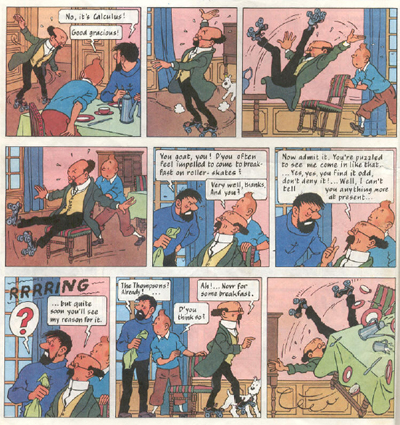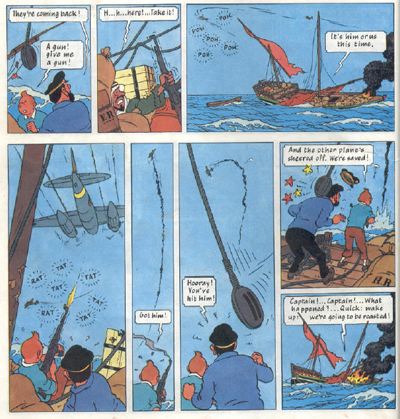In the lead-up to the release of The Adventures of Tintin: The Secret of the Unicorn, I’m going to be taking a look at Hergé’s celebrated comic book character, from his humble beginnings through to the incomplete post-modern finale. I hope you enjoy the ride.
The Red Sea Sharks is, I suppose, a fine adventure tale, even if it’s not an entry in Hergé’s canon that I’m particularly fond of. The nineteenth instalment in the series, the author uses the opportunity to tie a whole slew of open story threads together and anchor the long-term continuity of the series, but he also decides to deal with the issue of modern slavery – a controversial and topical issue, to be sure. However, while I have no doubt the author’s intentions were true, the story reads more than a little awkwardly in dealing with the topic.
The next two adventures in the series, Tintin in Tibet and The Castafiore Emerald, mark a serious departure for the character and the author – they feel somewhat more bold and adventurous than the vast majority of the adventures that came before. Even when Hergé would return to slightly more conventional adventure stories in Flight 714, things didn’t feel quite the same – there was a more surrealist sort of angle to the stories. So The Red Sea Sharks probably reads best as the last prototypical adventure in the long-running series, an attempt to draw together various disparate elements of an increasingly expansive canon into one cohesive continuity.
Not only do a huge number of Tintin’s allies recur, but it seems that the young reporter’s foes have organised themselves into something akin to a comic book “legion of doom.” It seems like virtually every bad guy Tintin has ever encountered is conspiring and working together as part of this gigantic evil slave-trading operation. Some of those involved are even so relatively obscure that Hergé has Tintin explain their shared history in handy exposition. “Good heavens! It’s Dawson. I’ve met him before. He was police chief in the International Settlement in Shang-hai.” I can honestly saw that, even reading the books close together like this, I probably would have missed that detail had it not been explained to me.
The story finds room from all sorts, including a short cameo from Doctor J. W. Müller himself and reappearance of Haddock’s treacherous first mate Allan, tempting the good captain with the demon drink. While all of this is a credit to the sheer level of detail in the world that Hergé has built, it can’t help but feel a little gimmicky and a little too hackneyed. I think it probably says something about me that I can accept Tintin and Haddock flying to the moon, but have a bit of bother with the idea of all of Tintin’s bad guys collaborating on one evil plot. Though, to be fair to Hergé, he seems to concede the point with the opening, where Haddock dismisses a movie’s plotting as “too improbable” in the way it ties the characters together.
In fairness, Hergé seems to have had a bit of sense of humour about his stories for quite a while now, and I like the way that he has Haddock actually call his friend Tintin on his incredibly reckless pursuit of mystery, to the point of putting the pair in the face of mortal danger. When clues lead overseas to an unstable country, as they seem to do with increasing frequency, Haddock actually wonders out loud why on earth they would fly into such obvious peril. “What? Khemed? In the middle of a revolution! You’re crazy!” Of course, the pair inevitably end up going, but it makes it clear that Hergé’s series of books are increasingly self-aware – a trend that would reach its zenith in The Castafiore Emerald.
Despite the hook of tying all Tintin’s foes together, it’s actually a fairly conventional adventure… at least if you discount the slave-trading at the centre of the story. I realise that Hergé undoubtedly intended to draw attention to a very serious international crime, but it’s hard to take it all seriously when the author seems quite clumsy in his manner of addressing it. His artwork has come a long way since the racist caricatures in Tintin in the Congo, but I still feel more than a little bit uncomfortable when I see Hergé draw Africans. It’s hard to believe that, as the sixties approached, the artist was still drawing the characters with stereotypically large lips and giving them condescending dialogue like, “We good black men… Want come out… No can breathe… We afraid…”
I know that certain characters in the stories don’t speak perfect English, but none of Hergé’s foreigners seem quite so underdeveloped. It takes the Africans a page to understand the idea Haddock is explaining to them: the notion that the trip to Mecca was a trap. More than that, though, Tintin and Haddock – while condemning the traders – don’t seem too concerned about the health of their passengers. They put out a fire on the ship at night, and it’s well past dawn when Tintin remarks, “And now for the Negroes.” Even then, Haddock isn’t concerned about the Africans trapped below decks (who might be sick, or injured, or even drowned), responding, “There’s something more urgent: to send out a distress signal by radio.” When they cry for help as Haddock is ready to let them out, he very dismissively exclaims, “All right, I’m coming now.”
However, there are other more awkward concerns. Emir Mohammed ben Kalish Ezab explains to Tintin about his dealings with the company, “I also used another threat: that I would reveal to the world that Arabair are involved in slave-trading.” This implies that the Emir was willing to allow the slave-trading to continue as long as he got what he needed – that the idea of people trafficking in slaves was not morally repugnant to him, and was only really of use as leverage in negotiations. That’s grand – I accept that bad people to exist in these stories – but I find it fascinating that Tintin remains on good terms with a person like that. It just seems inherently wrong to keep babysitting for somebody like that, and Tintin give no indication of any objection to the Emir’s approach.
Maybe I’m reading too much into it, but it does bother me. And, truth be told, it overshadows the story a bit. The Red Sea Sharks is about as conventional a Tintin story as you can get – and it features some wonderful art from Hergé – but I never really warmed to it. I had a bit of difficulty with how Hergé handled his racially-themed content, and I also found the “all of Tintin’s bad guys working together” plot point a little forced. Still, things were about to get considerably different.
Filed under: Comics | Tagged: adventures of tintin: red sea sharks, Captain Haddock, Castafiore Emerald, Flight 714, Hergé, List of The Adventures of Tintin characters, red sea sharks, steven spielberg, The Adventures of Tintin: Secret of the Unicorn, the adventures of tintin: the red sea sharks, the red sea sharks, tintin and the red sea sharks, Tintin in the Congo, tintin: the red sea sharks |
























Leave a comment